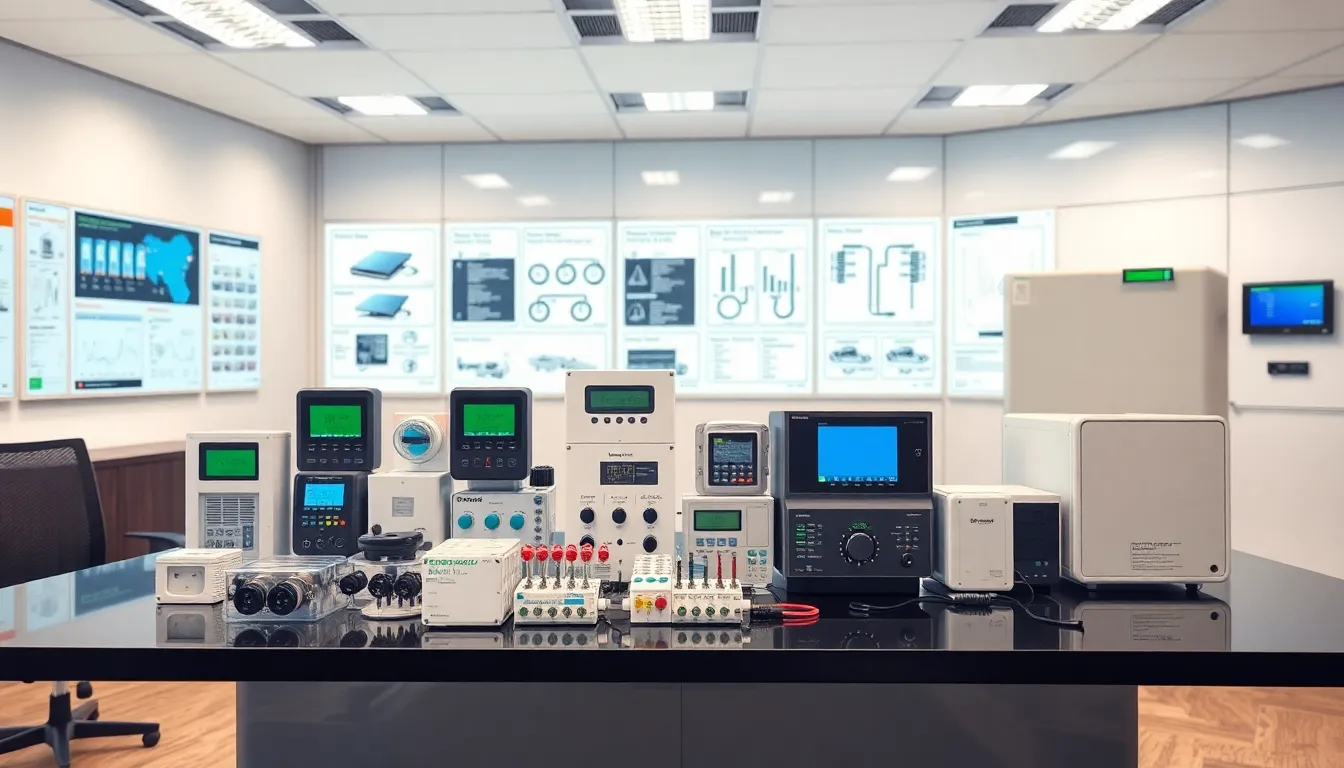In today’s world, where energy efficiency is crucial, energy management systems (EMS) have emerged as essential tools for organizations striving to optimize their energy usage. These systems provide a structured approach to monitoring, controlling, and conserving energy, enabling businesses to reduce costs while minimizing their environmental impact.
As energy demands continue to rise, the need for effective management solutions becomes increasingly important. EMS not only help in tracking energy consumption but also offer insights that drive smarter decision-making. By leveraging advanced technologies and data analytics, organizations can identify inefficiencies and implement strategies that lead to sustainable energy practices. Understanding the potential of energy management systems is key to unlocking significant savings and fostering a greener future.
Table of Contents
ToggleOverview Of Energy Management Systems
Energy management systems (EMS) serve as frameworks for monitoring, controlling, and conserving energy in buildings and industrial processes. An EMS helps organizations streamline energy usage, implement sustainability strategies, and improve overall efficiency.
Key components of EMS include:
- Data Collection: EMS uses sensors and smart meters to collect real-time data on energy consumption, allowing for precise tracking of usage patterns.
- Analysis Tools: EMS employs analytics software to process collected data, identify patterns, and highlight areas for improvement.
- User Interface: An intuitive user interface facilitates easy access to energy data and insights, making it straightforward for users to make informed decisions.
- Reporting Functions: EMS generates detailed reports that provide insights into energy performance, facilitating compliance with regulations and aiding strategic planning.
Organizations that implement effective EMS experience various benefits. Reduced energy costs stem from optimized consumption, while improved operational efficiency contributes to a favorable return on investment. Additionally, EMS supports sustainability initiatives, enhancing corporate responsibility and improving brand image.
Recent advancements in EMS technologies, such as artificial intelligence and machine learning, have further improved forecasting and predictive maintenance. These innovations enable real-time adjustments and significantly enhance an organization’s ability to respond to changing energy demands.
The integration of renewable energy sources, such as solar and wind, with EMS encourages the adoption of cleaner energy solutions, supporting broader environmental goals. By embracing energy management systems, organizations position themselves as leaders in energy efficiency and sustainability.
Key Components Of Energy Management Systems

Energy management systems consist of essential components that work together to optimize energy usage and enhance operational efficiency. These components can be categorized into hardware and software, each playing a critical role.
Hardware Components
- Sensors: Devices that measure energy consumption in real-time, providing accurate data on usage across systems.
- Smart Meters: Advanced meters that enable two-way communication with energy suppliers, facilitating better tracking of energy consumption patterns.
- Controllers: Hardware that manages energy systems, adjusting operations based on data inputs to optimize energy use and performance.
- Thermostats: Devices that regulate temperature settings, ensuring comfortable environments while minimizing energy waste.
- Energy Storage Systems: Technologies like batteries that store excess energy, allowing organizations to manage demand efficiently and utilize renewable sources effectively.
Software Components
- Data Analytics Tools: Platforms that process and analyze energy data, identifying trends and anomalies to improve energy management strategies.
- User Interfaces: Dashboards that display insights and metrics, allowing users to monitor energy performance easily and make informed decisions.
- Reporting Systems: Software that generates compliance reports and sustainability metrics, aiding in strategic planning and operational assessments.
- Forecasting Tools: Applications that utilize algorithms to predict energy demand and optimize resource allocation, ensuring cost-effective operations.
- Integration Platforms: Software solutions that connect various energy systems, facilitating seamless communication and enhancing overall system performance.
Benefits Of Implementing Energy Management Systems
Energy management systems (EMS) provide organizations with significant advantages, particularly in cost reduction and operational efficiency.
Cost Savings
Cost savings emerge as a primary benefit of EMS implementation. Organizations experience reduced energy bills through optimized energy consumption and demand response strategies. By monitoring real-time usage, businesses identify inefficient practices and rectify them swiftly. For instance, adopting automated controls may lead to energy savings of 10% to 30%. Moreover, compliance with energy regulations often incurs fewer penalties, further lowering operational expenses.
Improved Efficiency
Improved efficiency results from the integration of EMS, which enhances overall operational performance. By providing detailed insights into energy consumption patterns, organizations can implement targeted measures that reduce waste and streamline processes. EMS often leads to performance improvements of 15% or more in various sectors. The automation of energy controls minimizes manual intervention, allowing staff to focus on core business activities. Additionally, predictive maintenance capabilities ensure that equipment operates within optimal conditions, preventing costly downtime and extending asset lifespan.
Challenges In Energy Management Systems
Energy management systems (EMS) face various challenges that can hinder their effectiveness. Addressing these challenges is crucial to ensure optimal performance and decision-making.
Technical Challenges
Technical challenges often arise due to the complexity of integrating various hardware and software components. Issues include:
- Data Integration: Integrating data from multiple sources, such as sensors and smart meters, can lead to compatibility issues, reducing system reliability.
- System Scalability: As organizations grow, the EMS must scale accordingly, which can present obstacles in infrastructure and performance.
- Cybersecurity Risks: Increasing reliance on digital systems exposes EMS to potential cyber threats, necessitating robust security measures.
- Measurement Accuracy: Achieving precise and reliable measurements from sensors is essential for effective monitoring and data analysis.
- Interoperability: Ensuring seamless communication among different systems remains a major technical hurdle, often resulting in operational inefficiencies.
Organizational Challenges
- Stakeholder Resistance: Employees may resist adopting new technologies or practices, impeding effective system use.
- Insufficient Training: Lack of proper training for staff leads to underutilization of EMS features, hindering overall performance improvements.
- Budget Constraints: Limited financial resources can restrict investment in necessary hardware, software, and support services, affecting system effectiveness.
- Changing Regulations: Navigating evolving energy regulations can complicate compliance and strategic planning.
- Lack of Leadership Support: Without strong buy-in from leadership, energy management initiatives may fail to gain momentum or secure necessary resources.
Future Trends In Energy Management Systems
Future trends in energy management systems (EMS) reflect a shift towards more sustainable and efficient energy practices, driven largely by technology advancements and the integration of renewable energy sources.
Integration With Renewable Energy Sources
Integration with renewable energy sources marks a significant trend within EMS. Solar, wind, and other renewable sources are now essential components for organizations aiming to reduce their carbon footprint. EMS facilitate seamless connections to these renewable sources, allowing for better management of energy generation and consumption. By incorporating energy storage systems, such as batteries, organizations can store excess energy produced during peak generation times for later use. This practice not only enhances energy reliability but also aligns with sustainability goals, ultimately contributing to a decline in greenhouse gas emissions. Moreover, dynamic energy management strategies enable real-time decision-making on energy sourcing, ensuring optimal use of renewable energy, which can account for up to 30% of total energy consumption in progressive organizations.
Advancements In Technology
Advancements in technology significantly enhance the capabilities of energy management systems. Artificial intelligence and machine learning algorithms enable predictive analytics for better forecasting of energy demands and supply fluctuations. These technologies can adjust energy usage patterns dynamically, ultimately optimizing operational efficiency. Also, the implementation of the Internet of Things (IoT) fuels real-time data collection from various sensors and smart devices, increasing visibility into energy usage at granular levels. Cloud computing solutions simplify storage and processing of large datasets, allowing faster access to insights and analytics. Furthermore, blockchain technology improves transparency and security in energy transactions, thereby facilitating peer-to-peer energy trading. These technological developments not only streamline energy management processes but also support proactive maintenance, enabling organizations to maintain high operational standards while minimizing downtime.
Energy management systems are essential for organizations striving to enhance efficiency and sustainability. By leveraging advanced technologies and data analytics, EMS not only optimize energy consumption but also support significant cost savings and operational improvements. As organizations face increasing energy demands, the adoption of EMS becomes crucial for maintaining a competitive edge while contributing to environmental goals.
Navigating the challenges of implementation is key to unlocking the full potential of these systems. With ongoing advancements in technology and a growing emphasis on renewable energy integration, organizations that prioritize energy management will lead the way toward a more sustainable future. Embracing EMS is not just a strategic move; it’s a commitment to responsible energy use and corporate accountability.
